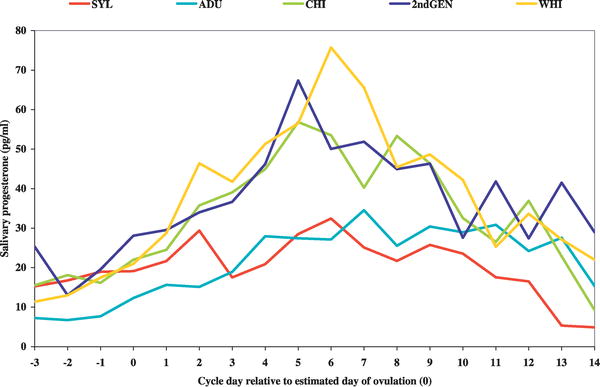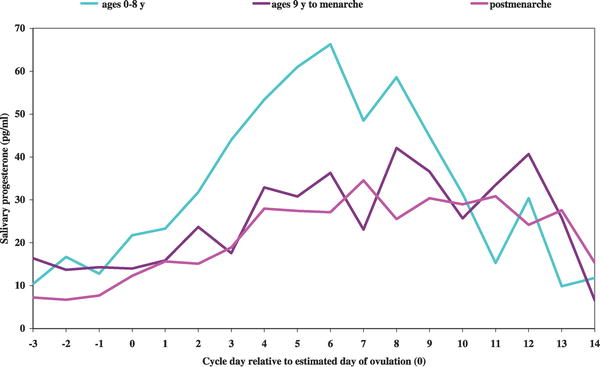Talk:Menstrual Cycle
2010
Menstrual cycle and hormonal contraceptive use modulate human brain structure
Brain Res. 2010 Aug 12;1348:55-62. Epub 2010 Jun 13.
Pletzer B, Kronbichler M, Aichhorn M, Bergmann J, Ladurner G, Kerschbaum HH.
Department of Cell Biology, Paris-Lodron-University Salzburg, Hellbrunnerstrasse 34, 5020 Salzburg, Austria. Belinda.Pletzer@sbg.ac.at Abstract Sex differences in human brain structure have repeatedly been described, but results are inconsistent. However, these studies hardly controlled for cycle phase of women or the use of hormonal contraceptives. Our study shows that these factors are not negligible, but have a considerable influence on human brain structure. We acquired high-resolution structural images from the brains of 14 men, 14 women, who did not use, and 14 women, who did use hormonal contraceptives. Women, who did not use hormonal contraceptives, were scanned twice, once during their early follicular and once during their mid-luteal cycle-phase. Regional gray matter volumes were compared by voxel-based morphometry. Men had larger hippocampi, parahippocampal and fusiform gyri, amygdalae and basal ganglia than women. Women showed larger gray matter volumes in the prefrontal cortex, pre- and postcentral gyri. These sex-dependent effects were modulated by menstrual cycle phases and hormonal contraceptives. We found larger volumes in the right fusiform/parahippocampal gyrus during early follicular compared to mid-luteal cycle phase. Women using hormonal contraceptives showed significantly larger prefrontal cortices, pre- and postcentral gyri, parahippocampal and fusiform gyri and temporal regions, compared to women not using contraceptives.
PMID: 20550945
http://www.ncbi.nlm.nih.gov/pubmed/20550945
Human studies on genetics of the age at natural menopause: a systematic review
Abstract
BACKGROUND Timing of natural menopause has great implications for fertility and women's health. Age at natural menopause (ANM) is largely influenced by genetic factors. In the past decade, several genetic studies have been conducted to identify genes in ANM, which can help us unravel the biological pathways underlying this trait and the associated infertility and health risks. After providing an overview of the results of the genetic studies performed so far, we give recommendations for future studies in identifying genetic factors involved in determining the variation in timing of natural menopause.
METHODS The electronic databases of Pubmed and Embase were systematically searched until September 2009 for genetic studies on ANM, using relevant keywords on the subject. Additional papers identified through hand search were also included.
RESULTS Twenty-eight papers emerged from our literature search. A number of genetic regions and variants involved in several possible pathways underlying timing of ANM were identified, including two possible interesting regions (9q21.3 and chromosome 8 at 26 cM) in linkage analyses. Recent genome-wide association studies have identified two genomic regions (19q13.42 and 20p12.3), containing two promising candidate genes (BRKS1 and MCM). In the candidate gene association studies on ANM, very few consistent associations were found.
CONCLUSION A number of genetic variants have been discovered in association with ANM, although the overall results have been rather disappointing. We have described possible new strategies for future genetic studies to identify more genetic loci involved in the variation in menopausal age.
http://humupd.oxfordjournals.org/content/16/4/364.abstract
Expression of nodal signalling components in cycling human endometrium and in endometrial cancer
http://www.rbej.com/content/7/1/122
Postnatal Cycle Flexibility
A recent paper has demonstrated that the human menstral cycle can be modulated postnatally by environmental conditions as measured by changes in progesterone based upon age of migration from a relatively poor environment (Bangladesh) to a relatively better environment (UK). Childhood conditions influence adult progesterone levels. Núñez-de la Mora A, Chatterton RT, Choudhury OA, Napolitano DA, Bentley GR. PLoS Med. 2007 May;4(5):e167. PMID: 17503960 | PLoS Medicine
 |
SYL - resident Bangladeshi sedentees from Sylhet
ADU - adult migrants CHI - child migrants 2ndGEN - second-generation British-Bangladeshis WHI - British women of European descent Unadjusted mean luteal progesterone index values. Ovulation dates were estimated from oestradiol data available for the same individual menstrual cycles. (More? PLoS Medicine - Article) |
 |
Women who migrated during infancy and early childhood (ages 0–8 y) had a significantly earlier age at menarche.
Women who migrated after menarche, length of time spent in the UK had no significant impact on luteal progesterone levels. (More? PLoS Medicine - Article) |
Data: Nunez-de la Mora A, Chatterton RT, Choudhury OA, Napolitano DA, Bentley GR. Childhood Conditions Influence Adult Progesterone Levels. PLoS Med. 2007 May 15;4(5):e167 (More? PLoS Medicine - Article)
Menstruation in Adolescents
http://www.ncbi.nlm.nih.gov/pmc/articles/PMC2644006/?tool=pubmed
- precocious puberty has been defined as any pubertal development occurring before age 8
- paper shows earlier timings
- range for menstrual cycles in adolescents is wider than in adults
- adult normal cycle length is defined as being between 21 and 34 days.
terminologies and definitions used to describe abnormalities of menstrual bleeding
Can we achieve international agreement on terminologies and definitions used to describe abnormalities of menstrual bleeding? Fraser IS, Critchley HO, Munro MG, Broder M. Hum Reprod. 2007 Mar;22(3):635-43. Epub 2007 Jan 4. PMID: 17204526 | Hum Reprod.
- terminologies and definitions around the symptom of abnormal uterine bleeding (AUB)
- The major recommendations were to replace terms such as menorrhagia, metrorrhagia, hypermenorrhoea and dysfunctional uterine bleeding.
- four key ‘menstrual dimensions’ should be cycle regularity, frequency of menstruation, duration and volume of menstrual flow.
- Regularity should be specified as irregular, regular or absent.
- Frequency should be specified as frequent, normal or infrequent.
- Duration should be specified as prolonged, normal or shortened.
- Volume should be specified as heavy, normal or light.
Table VII. Suggested normal limits for menstrual parameters in the mid-reproductive years
Clinical dimensions of menstruation and menstrual cycle Descriptive terms Normal limits (5th–95th percentiles) Frequency of menses (days) Frequent <24 Normal 24–38 Infrequent >38 Regularity of menses (cycle to cycle variation over 12 months; in days) Absent — Regular Variation ± 2 to 20 days Irregular Variation greater than 20 days Duration of flow (days) Prolonged >8.0 Normal 4.5–8.0 Shortened <4.5 Volume of monthly blood loss (ml) (Hallberg et al., 1966) Heavy >80 Normal 5–80 Light <5
corpus luteum
Luteal blood flow and luteal function. Takasaki A, Tamura H, Taniguchi K, Asada H, Taketani T, Matsuoka A, Yamagata Y, Shimamura K, Morioka H, Sugino N. J Ovarian Res. 2009 Jan 14;2:1. PMC2633338]
- During corpus luteum formation
- active angiogenesis occurs after the ovulatory LH surge
- corpus luteum becomes one of the most highly vascularized organs in the body PMID: 9500609
- corpus luteum blood flow
- necessary to provide luteal cells with the large amounts of cholesterol needed for progesterone synthesis
- to deliver progesterone to the circulation.
Sleep, Hormones, and Circadian Rhythms throughout the Menstrual Cycle
Sleep, Hormones, and Circadian Rhythms throughout the Menstrual Cycle in Healthy Women and Women with Premenstrual Dysphoric Disorder. Shechter A, Boivin DB. Int J Endocrinol. 2010;2010:259345. Epub 2010 Jan 18. PMID: 20145718 | PMC2817387
- relationship exists between the sleep-wake cycle and hormone secretion
- melatonin, cortisol, thyroid stimulating hormone (TSH), and prolactin (PRL), vary across the 24-hour day and are highly regulated by the circadian and sleep-wake cycles.
- sleep complaints commonly occur during the postovulatory luteal phase (LP) in healthy women
- premenstrual dysphoric disorder (PMDD) - a DSM-IV classified menstrual cycle-related mood disorder
endometrial and ovarian characteristics using three dimensional power Doppler ultrasound
http://www.rbej.com/content/7/1/151
patients who finally conceived was the presence of a triple-line pattern in the endometrium
Quantity and quality of retrograde menstruation: a case control study
http://www.ncbi.nlm.nih.gov/pmc/articles/PMC2789082/?tool=pubmed
- menstruation is associated with a higher concentration of endometrial cells in peritoneal fluid (PF)
- comparison with the nonmenstrual phase of the cycle, analysis of PF during menstruation showed an increased concentration of leucocytes (3.3 × 109/L vs 0.8 × 109/L, P = 0.03), erythrocytes (0.3 × 1012/L vs 0.02 × 1012/L, P = 0.006), hematocrit (0.03 L/L vs 0.003 L/L, P = 0.01) and hemoglobin (0.8 g/dL vs 0.1 g/dL, P = 0.01).
luteal phase changes
Suggested changes include:
- fluid retention, weight gain, increased energy demands, changes in glucose uptake, a slower gastrointestinal transit time, altered lipid profiles, altered vitamin D, calcium, magnesium and iron metabolism, emotional hypersensitivity, generalized pain, and changes in dietary habits.
Changes in serum calcium, magnesium and inorganic phosphorus levels during different phases of the menstrual cycle. Dullo P, Vedi N. J Hum Reprod Sci. 2008 Jul;1(2):77-80. PMID: 19562050
Women's sexual interest
http://www.ncbi.nlm.nih.gov/pubmed/19306881
Women's sexual interest changes with hormonal fluctuations across the menstrual cycle.
- "The observed increase in activation in the right medial orbitofrontal cortex (OFC) during the follicular phase may reflect a hormonally mediated increase in appetitive motivation and may prime women towards increased sexual interest and behavior around ovulation."
Progesterone and Progestin Receptors in the Brain
http://www.ncbi.nlm.nih.gov/pubmed/18436712 http://endo.endojournals.org/cgi/content/full/149/6/2737